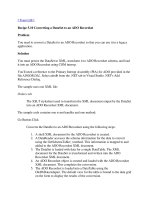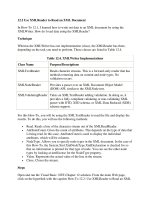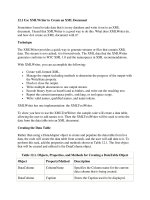Tài liệu Synchronizing a DataSet with an XML Document pptx
Bạn đang xem bản rút gọn của tài liệu. Xem và tải ngay bản đầy đủ của tài liệu tại đây (22.58 KB, 9 trang )
[ Team LiB ]
Recipe 8.3 Synchronizing a DataSet with an XML Document
Problem
You need to work with both a DataSet and its XML representation.
Solution
Use a synchronized DataSet and XmlDataDocument.
The sample code contains two event handlers and one method:
Go Button.Click
Synchronizes a DataSet and an XmlDataDocument using one of three methods
specified by the user. The default view for the Orders table of the DataSet is bound
to the data grid on the form and the contents of the XmlDataDocument are
displayed in the text box.
Clear Button.Click
Clears the contents of the data grid displaying the DataSet and the text box
displaying the contents of the XmlDataDocument.
FillDataSet( )
This method loads the DataSet with a subset of the Orders and Order Details data
from Northwind and creates a relation between the tables.
The C# code is shown in Example 8-5
.
Example 8-5. File: SyncDataSetWithXmlDocForm.cs
// Namespaces, variables, and constants
using System;
using System.Configuration;
using System.Windows.Forms;
using System.Xml;
using System.Data;
using System.Data.SqlClient;
// Table name constants
private const String ORDERS_TABLE = "Orders";
private const String ORDERDETAILS_TABLE = "OrderDetails";
// Relation name constants
private const String ORDERS_ORDERDETAILS_RELATION =
"Orders_OrderDetails_Relation";
// Field name constants
private const String ORDERID_FIELD = "OrderID";
private const String XMLFILENAME =
ConfigurationSettings.AppSettings["Project_Directory"] +
@"Chapter 08\Orders_OrderDetails.xml";
// . . .
private void goButton_Click(object sender, System.EventArgs e)
{
Cursor.Current = Cursors.WaitCursor;
DataSet ds = null;
XmlDataDocument xmlDoc = null;
if (method1RadioButton.Checked)
{
// Load DataSet with schema and data.
ds = FillDataSet(true);
// Get the XML document for the DataSet.
xmlDoc = new XmlDataDocument(ds);
}
else if(method2RadioButton.Checked)
{
// Create DataSet with schema, but no data.
ds = FillDataSet(false);
// Get the XML document for the DataSet.
xmlDoc = new XmlDataDocument(ds);
// Load the data into the XML document from the XML file.
xmlDoc.Load(XMLFILENAME);
}
else if(method3RadioButton.Checked)
{
// Create an XML document.
xmlDoc = new XmlDataDocument( );
// Get the DataSet for the XML document.
ds = xmlDoc.DataSet;
// Get schema for the DataSet from the XSD inline schema.
ds.ReadXmlSchema(XMLFILENAME);
// Load the data into the XML document from the XML file.
xmlDoc.Load(XMLFILENAME);
}
// Display the XML data.
resultTextBox.Text = xmlDoc.OuterXml;
// Bind the DataSet to the grid.
dataGrid.DataSource = ds.Tables[ORDERS_TABLE].DefaultView;
Cursor.Current = Cursors.Default;
}
private DataSet FillDataSet(bool includeData)
{
DataSet ds = new DataSet("Orders_OrderDetails");
SqlDataAdapter da;
// Fill the Order table and add it to the DataSet.
da = new SqlDataAdapter("SELECT * FROM Orders",
ConfigurationSettings.AppSettings["Sql_ConnectString"]);
DataTable orderTable = new DataTable(ORDERS_TABLE);
da.FillSchema(orderTable, SchemaType.Source);
if (includeData)
da.Fill(orderTable);
ds.Tables.Add(orderTable);
// Fill the OrderDetails table with schema and add it to the DataSet.
da = new SqlDataAdapter("SELECT * FROM [Order Details]",
ConfigurationSettings.AppSettings["Sql_ConnectString"]);
DataTable orderDetailTable = new DataTable(ORDERDETAILS_TABLE);
da.FillSchema(orderDetailTable, SchemaType.Source);
if (includeData)
da.Fill(orderDetailTable);
ds.Tables.Add(orderDetailTable);
// Create a relation between the tables.
ds.Relations.Add(ORDERS_ORDERDETAILS_RELATION,
ds.Tables[ORDERS_TABLE].Columns[ORDERID_FIELD],
ds.Tables[ORDERDETAILS_TABLE].Columns[ORDERID_FIELD],
true);
return ds;
}
Discussion
The .NET Framework allows real-time, synchronous access to both a DataSet and its
XML representation in an XmlDataDocument object. The synchronized DataSet and
XmlDataDocument work with a single set of data.
The solution shows three ways to synchronize a DataSet with an XmlDataDocument:
Method 1
Populate a DataSet with both schema and data. Synchronize it with a new
XmlDataDocument, initializing it with the DataSet in the constructor.
Method 2
Populate a DataSet with a schema but no data. Synchronize it with a new
XmlDataDocument, initializing it with the DataSet in the constructor. Load an
XML document into the XmlDataDocument. The table and column names in the
DataSet schema to be synchronized must match those in the XmlDataDocument.
Method 3
Create a new XmlDataDocument and access its DataSet through the DataSet
property. Populate the schema for the DataSet. In the example, the schema is read
from the XSD inline schema in the XML document. If the XML document does
not have an inline schema, it might be possible to infer the schema using the
InferSchema( ) method. Otherwise, the entire DataSet schema must be defined
programmatically. Next, load the XML document into the synchronized
XmlDataDocument. The table and column names in the DataSet schema to be
synchronized must match those in the XmlDataDocument.
Example 8-6
shows the XML file used in this solution.
Example 8-6. Orders with Order Details XML file, with schema
<Orders_OrderDetails>
<xs:schema id="Orders_OrderDetails" xmlns=""
xmlns:xs="
xmlns:msdata="urn:schemas-microsoft-com:xml-msdata">
<xs:element name="Orders_OrderDetails" msdata:IsDataSet="true">
<xs:complexType>
<xs:choice maxOccurs="unbounded">
<xs:element name="Orders">
<xs:complexType>
<xs:sequence>
<xs:element name="OrderID" msdata:ReadOnly="true"
msdata:AutoIncrement="true" type="xs:int" />
<xs:element name="CustomerID" minOccurs="0">
<xs:simpleType>
<xs:restriction base="xs:string">
<xs:maxLength value="5" />
</xs:restriction>
</xs:simpleType>
</xs:element>
<xs:element name="EmployeeID" type="xs:int"
minOccurs="0" />
<xs:element name="OrderDate" type="xs:dateTime"
minOccurs="0" />
<xs:element name="RequiredDate" type="xs:dateTime"
minOccurs="0" />
<xs:element name="ShippedDate" type="xs:dateTime"
minOccurs="0" />
<xs:element name="ShipVia" type="xs:int" minOccurs="0" />
<xs:element name="Freight" type="xs:decimal"
minOccurs="0" />
<xs:element name="ShipName" minOccurs="0">
<xs:simpleType>
<xs:restriction base="xs:string">
<xs:maxLength value="40" />
</xs:restriction>
</xs:simpleType>
</xs:element>
<xs:element name="ShipAddress" minOccurs="0">
<xs:simpleType>
<xs:restriction base="xs:string">
<xs:maxLength value="60" />
</xs:restriction>
</xs:simpleType>
</xs:element>
<xs:element name="ShipCity" minOccurs="0">
<xs:simpleType>
<xs:restriction base="xs:string">
<xs:maxLength value="15" />
</xs:restriction>
</xs:simpleType>
</xs:element>
<xs:element name="ShipRegion" minOccurs="0">
<xs:simpleType>
<xs:restriction base="xs:string">
<xs:maxLength value="15" />
</xs:restriction>
</xs:simpleType>
</xs:element>
<xs:element name="ShipPostalCode" minOccurs="0">
<xs:simpleType>
<xs:restriction base="xs:string">
<xs:maxLength value="10" />
</xs:restriction>
</xs:simpleType>
</xs:element>
<xs:element name="ShipCountry" minOccurs="0">
<xs:simpleType>
<xs:restriction base="xs:string">
<xs:maxLength value="15" />
</xs:restriction>
</xs:simpleType>
</xs:element>
</xs:sequence>
</xs:complexType>
</xs:element>
<xs:element name="OrderDetails">
<xs:complexType>
<xs:sequence>
<xs:element name="OrderID" type="xs:int" />
<xs:element name="ProductID" type="xs:int" />
<xs:element name="UnitPrice" type="xs:decimal" />
<xs:element name="Quantity" type="xs:short" />
<xs:element name="Discount" type="xs:float" />
</xs:sequence>
</xs:complexType>
</xs:element>
</xs:choice>
</xs:complexType>
<xs:unique name="Constraint1" msdata:PrimaryKey="true">
<xs:selector xpath=".//Orders" />
<xs:field xpath="OrderID" />
</xs:unique>
<xs:unique name="OrderDetails_Constraint1"
msdata:ConstraintName="Constraint1" msdata:PrimaryKey="true">
<xs:selector xpath=".//OrderDetails" />
<xs:field xpath="OrderID" />
<xs:field xpath="ProductID" />
</xs:unique>
<xs:keyref name="Orders_OrderDetails_Relation" refer="Constraint1">
<xs:selector xpath=".//OrderDetails" />
<xs:field xpath="OrderID" />
</xs:keyref>
</xs:element>
</xs:schema>
<Orders>
<OrderID>10248</OrderID>
<CustomerID>VINET</CustomerID>
<EmployeeID>5</EmployeeID>
<OrderDate>1996-07-04T00:00:00.0000000-04:00</OrderDate>
<RequiredDate>1996-08-01T00:00:00.0000000-04:00</RequiredDate>
<ShippedDate>1996-07-16T00:00:00.0000000-04:00</ShippedDate>
<ShipVia>3</ShipVia>
<Freight>32.38</Freight>
<ShipName>Vins et alcools Chevalier</ShipName>
<ShipAddress>59 rue de l'Abbaye</ShipAddress>
<ShipCity>Reims</ShipCity>
<ShipPostalCode>51100</ShipPostalCode>
<ShipCountry>France</ShipCountry>
</Orders>
<Orders>
<OrderID>10249</OrderID>
<CustomerID>TOMSP</CustomerID>
<EmployeeID>6</EmployeeID>
<OrderDate>1996-07-05T00:00:00.0000000-04:00</OrderDate>
<RequiredDate>1996-08-16T00:00:00.0000000-04:00</RequiredDate>
<ShippedDate>1996-07-10T00:00:00.0000000-04:00</ShippedDate>
<ShipVia>1</ShipVia>
<Freight>11.61</Freight>
<ShipName>Toms Spezialitäten</ShipName>
<ShipAddress>Luisenstr. 48</ShipAddress>
<ShipCity>Münster</ShipCity>
<ShipPostalCode>44087</ShipPostalCode>
<ShipCountry>Germany</ShipCountry>
</Orders>
<Orders>
<OrderID>10250</OrderID>
<CustomerID>HANAR</CustomerID>
<EmployeeID>4</EmployeeID>
<OrderDate>1996-07-08T00:00:00.0000000-04:00</OrderDate>
<RequiredDate>1996-08-05T00:00:00.0000000-04:00</RequiredDate>
<ShippedDate>1996-07-12T00:00:00.0000000-04:00</ShippedDate>
<ShipVia>2</ShipVia>
<Freight>65.83</Freight>
<ShipName>Hanari Carnes</ShipName>
<ShipAddress>Rua do Paço, 67</ShipAddress>
<ShipCity>Rio de Janeiro</ShipCity>
<ShipRegion>RJ</ShipRegion>
<ShipPostalCode>05454-876</ShipPostalCode>
<ShipCountry>Brazil</ShipCountry>
</Orders>
<OrderDetails>
<OrderID>10248</OrderID>
<ProductID>11</ProductID>
<UnitPrice>14</UnitPrice>
<Quantity>12</Quantity>
<Discount>0</Discount>
</OrderDetails>
<OrderDetails>
<OrderID>10248</OrderID>
<ProductID>42</ProductID>
<UnitPrice>9.8</UnitPrice>
<Quantity>10</Quantity>
<Discount>0</Discount>
</OrderDetails>
<OrderDetails>
<OrderID>10248</OrderID>
<ProductID>72</ProductID>
<UnitPrice>34.8</UnitPrice>
<Quantity>5</Quantity>
<Discount>0</Discount>
</OrderDetails>
<OrderDetails>
<OrderID>10249</OrderID>
<ProductID>14</ProductID>
<UnitPrice>18.6</UnitPrice>
<Quantity>9</Quantity>
<Discount>0</Discount>
</OrderDetails>
<OrderDetails>
<OrderID>10249</OrderID>
<ProductID>51</ProductID>
<UnitPrice>42.4</UnitPrice>
<Quantity>40</Quantity>
<Discount>0</Discount>
</OrderDetails>
<OrderDetails>
<OrderID>10250</OrderID>
<ProductID>41</ProductID>
<UnitPrice>7.7</UnitPrice>
<Quantity>10</Quantity>
<Discount>0</Discount>
</OrderDetails>
<OrderDetails>
<OrderID>10250</OrderID>
<ProductID>51</ProductID>
<UnitPrice>42.4</UnitPrice>
<Quantity>35</Quantity>
<Discount>0.15</Discount>
</OrderDetails>
<OrderDetails>
<OrderID>10250</OrderID>
<ProductID>65</ProductID>
<UnitPrice>16.8</UnitPrice>
<Quantity>15</Quantity>
<Discount>0.15</Discount>
</OrderDetails>
</Orders_OrderDetails>
[ Team LiB ]









